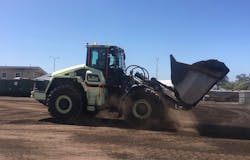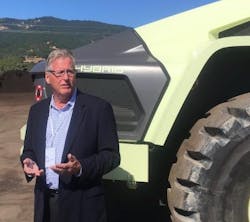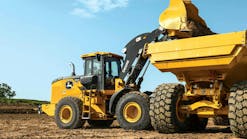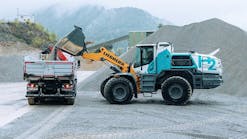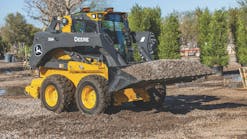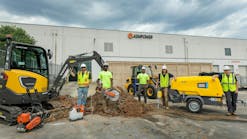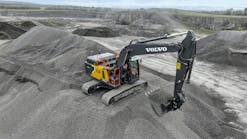Volvo Construction Equipment’s prototype LX1 electric hybrid wheel loader, teased as far back as 2008 and unveiled to the press and potential customers last September in Sweden, finally has some real world results under its belt.
Waste Management tested the unit for six months and hundreds of hours at its Redwood Landfill and Recycling Center, a green waste facility in Novato, Calif., as well as its Moreno Valley, Calif., transfer station.
The LX1 incorporates a driveline that consists of electric drive motors mounted at the wheels, electric-driven hydraulics, a battery energy storage system, a significantly smaller diesel engine (3.5L) and new machine architecture. Volvo says the prototype features 98 percent new parts and is capable of doing the work of a wheel loader one size larger.
In Novato, both fuel efficiency and greenhouse gas emission tests were conducted, and although the data is still being analyzed, Volvo says, the results so far show an average improvement of 50 percent in fuel efficiency, equating to a reduction of 35 percent in fuel consumption and greenhouse gas emissions. At Moreno Valley, the loader achieved an average fuel efficiency improvement of around 45 percent. Volvo noted that both sets of results exceed the 35 percent fuel efficiency improvement target set for the project.
CALSTART conducted emissions tests on the machine, and the California Energy Commission helped fund the LX1 project in California to the tune of $1.8 million through its Alternative and Renewable Fuel and Vehicle Technology Program. The program invests up to $100 million per year to support advancements in alternative, renewable fuels and the vehicles powered by them.
“We’re pleased with the results from the field testing,” says Scott Young, electromobility director at Volvo CE. “Although we’d already seen the LX1 reach up to a 50 percent improvement in fuel efficiency in our internal tests, every application and operator are different. Because of this, we were aiming for a 35 percent improvement in fuel efficiency in this project. We’re happy to say that we’ve significantly exceeded this figure and achieved similar results to those recorded at our test site in Sweden.
“Now that we’ve concluded the field tests, the machine will be shipped back to Sweden for updates and tuning based on what we’ve learned over the last six months,” Young says. “At this stage, the LX1 is still part of a development project and it is not commercially available.”
John Meese (left), senior director of heavy equipment for Waste Management, says commercial availability is three years away, but the equipment managers who will have pride in being early adopters will need to balance the technology’s initial cost with lifecycle savings.
“I think there are a lot of end users that are going to jump on board to say ‘I got the first one in Chicago,’ ‘I got the first one in California,’” Meese says. “But there’s a price point issue that nobody knows yet what it [the initial cost] is.
“We kind of push and push, and hear, ‘Well, it’s not commercially available yet.’ I understand it’s going to cost more, but I have to start doing the business cases. I’ve got tire savings I can acknowledge. I have fuel savings that are pretty easy to acknowledge. I have wear and tear, because of the design differential—fewer wear parts,” Meese says. “Safety, I don’t know how you put a number on that, but that’s there.”
The LX1’s dramatically sloped hood due to a lack of Tier 4 emissions equipment allows increased visibility to the rear of the machine, and the hybrid runs quieter than conventional wheel loaders, potentially boosting job site communication.
“On the opposite side, that technology is not something our technicians are going to be able to deal with,” Meese says. “So I’m going to look at higher expense because it’s going to be dealer technicians that work on it, and are they going to be trained? So there are points to look to for a business case on why you could, besides the emotional factor of ‘Wow it’s the greatest thing since sliced bread.’ It’s going to be a tough call.”
Meese likened the adoption of the LX1 to the adoption of telematics. “I think it’s a little bit like telematics. Why would I want telematics? Why would I want a diesel electric hybrid? Well, think of all the things it could do for you.”
He also drew a parallel to federal jobs that mandated contractors use equipment conforming to the current Tier level. “If you look back when [regulations] went to Tier 3, there were a lot of customers who weren’t going to be able to bid or that were going to have to put a lot of rental equipment out there,” Meese says. “Will we get to the point where governmental agencies mandate that you have a certain percentage of your fleet as hybrids? That could be a point that drives some of those purchases, as well.”
